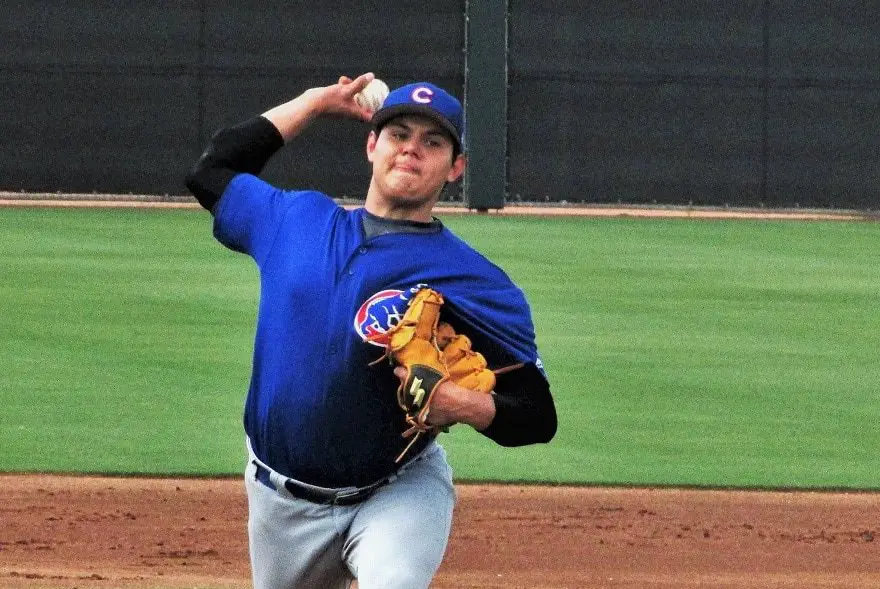
Cubs State of the System Address, Part 1: Big Picture Themes
At some point shortly after the season, Theo Epstein will address the media to talk about the state of the Cubs’ farm system. He’ll mention a few prospects he likes and he’ll talk about how excited or disappointed he was. For the most part, it will be a transparent procedure. It will be an insider’s’ analysis of a system with which he is very familiar.
If I was to do that analysis of the minor-league system, I would not be privy to a lot of information that Epstein gets from organizational leaders Jason McLeod and Jaron Madison. Even still, there are obvious things that you can see taking place throughout the system. I think the analysis begins with more big picture themes, like these:
Big Picture Themes
1. Ability to Develop Talent
I think the Cubs do well in this aspect. They can take an average player and suddenly make him seem worthwhile. They have shown the ability to take talent in the draft, international free agency, or in a trade, and polish them up to get them ready for the major leagues. On some days, you can find up to six position players drafted by the Cubs in Joe Maddon’s lineup.
In 2012, for example, catching was a definite weakness of the system and now the Cubs have developed that weakness into a strength with Willson Contreras, Victor Caratini, Alberto Mineo, and others.
2. Elite Talent
With the trades of this past summer, the Cubs really are devoid of elite talent right now. There is only one player that I can foresee making a Top-100 list this winter, and that is right-handed starter Jose Albertos — who will be just 19 years old in 2018. I think what the past five years showed us is that the Cubs can find and sign some of the top players in the game.
I just don’t see anybody that is currently at Double-A or Triple-A that fits that bill. Sure, there are a lot of nice players who could be bench guys or bullpen pieces at the major league level, but there’s not a top of the rotation starter or someone who could become an everyday position player over the next year. There may be a backup catcher and several fifth outfielders, but that’s it. However, at the lower levels, there are several prospects who could fill some roles in two or three years.
3. Risk and Reward
 This is the biggest theme in the system and trend of the past two years. Since the Cubs are not going to be drafting near the top of the first round, they have to be a little bit riskier and select players who they think have high ceilings but may not be the safest bet. For most of the past five years, the Cubs have signed mainly college players from the draft.
This is the biggest theme in the system and trend of the past two years. Since the Cubs are not going to be drafting near the top of the first round, they have to be a little bit riskier and select players who they think have high ceilings but may not be the safest bet. For most of the past five years, the Cubs have signed mainly college players from the draft.
A few times, they selected and signed high school players, most notably the pitching collection of Carson Sands, Justin Steele, Dylan Cease, and Austyn Willis. Only two of them are still Cubs. Sands did not have a good 2017 season coming off bone spur removal and Steele had Tommy John surgery in late August. Selecting four pitchers in one draft from high school carried with it a lot of risk and explains why the Cubs tend to focus on college arms.
However, this past year the Cubs selected and signed several high school players. Nelson Velasquez is a physically maxed-out outfielder with immense power. He was named the Cubs’ Minor League Player of the Month for August after cranking out six home runs for Mesa. Shortstop Luis Vasquez had an up-and-down season for Mesa, but he’s physically gifted and went 5-for-7 in two playoff games. Pitcher Jeremiah Estrada (sixth round, 2017) was the highest-ranked high school pitcher the Cubs selected since taking Bryan Hudson in the third round in 2015.
4. International Free Agent Strategies


The Cubs invested heavily in the Mexican market the past three summers. I don’t know how much that will change next summer under new CBA rules, where there is a strict cap. In 2013 and 2015, the Cubs went over their spending limit and acquired a lot of talent in doing so. Most of them are just now reaching stateside, some all the way up at Myrtle Beach. But that type of binge in international free agency cannot be done anymore. It will be interesting to see how they adapt this winter under the new CBA, with the expected pursuit of Japanese stud Shohei Otani.
I will be back next week with Part 2, looking at the strengths and weaknesses of the Cubs’ minor-league system.

